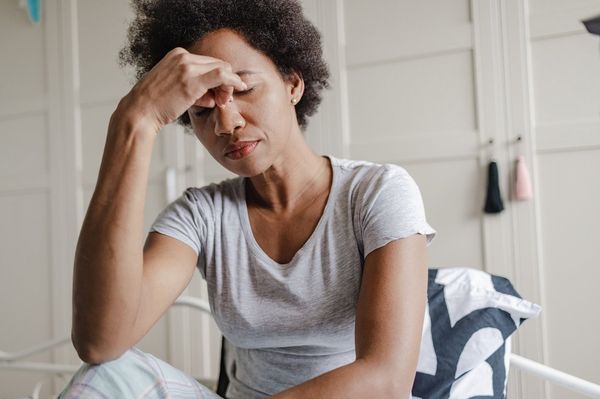Meditation has long been heralded as a pathway to good health, a practice that can help you unplug, de-stress and increase your happiness. Some even claim it can slow aging.
There is scientific research that suggests meditation can reduce blood pressure, help ease symptoms of irritable bowel syndrome, help relieve anxiety and depression and be a useful tool in treating insomnia.
But what if, despite your best efforts, you can't—or shouldn't—meditate? There are plenty of people who have trouble shutting off their "monkey brain" and attaining a state of sustained calm. Others might have physical limitations that make it difficult to practice certain meditative practices involving movement, or they might have a psychiatric condition (like anxiety or depression) that can be worsened by practicing meditation.
That's where breathing comes in. Just like meditation, its roots are ancient—and it can be used to your advantage in so many ways. It's your bodies built-in stress reliever.
Breaths can do a lot: They can wake, energize, relax and balance us.
Sure, we all breathe. But there are right and wrong ways to do what comes naturally to all of us, and it could make the difference between feeling stressed and feeling soothed and calm. Just think about how you feel when you're stressed; it's likely you're holding your breath at various times or taking shallow, quick breaths. Conversely, when you're relaxed, so is your breathing—deep, slow and thorough.
By consciously altering your breathing patterns, you send a signal to your brain to adjust your parasympathetic branch of your nervous system. What follows: a slower heart rate and digestion, feelings of calm and tranquility.
Feeling anxious? Breathing can be the quickest route toward calming down. When breathing slows, it changes signals in the brain that cause it to be aroused. Scientists found this when they experimented on mice and genetically altered specific neurons in their brains to isolate their effects on breathing.
There are so many ways to breathe. The next time you're feeling panicky, stressed, anxious or weary, try changing up your breathing patterns.
Here are just a few variations on breathing I've gathered from around the Internet to get you started. Of course, there's no one-size-fits-all solution, so feel free to try variations until you find the one(s) that suits you best.
Breath focus (from Harvard Medical School)This technique focuses on slow deep breathing, while helping you get your mind off distracting thoughts and feelings. If you tend to hold in your stomach when you breathe, practicing this can be helpful.
First, sit or lie down in a comfortable place. Then, after taking a normal breath, breathe in deeply. To take a deep breath, breathe in slowly through your nose, while allowing your chest and lower belly to rise as your lungs fill. Allow your abdomen to expand fully. Then, slowly let the breath out, exhaling through your mouth. (If it feels more natural to breathe out through your nose, that's OK).
After you've gone through these steps, you can practice a regular program of controlled breathing and combine deep breathing with imagery and/or a word or phrase to help deepen your relaxation.
Breathing for calm (from Anxieties.com)
This can slow you down when you're feeling anxious. Start by taking a long, slow breath in through your nose. First, fill your lower lungs, then your upper lungs. Hold that breath to a count of three.
Exhale slowly through pursed lips, while relaxing the muscles in your face, jaw, shoulders and abdomen.
Equal breathing (from Greatist)
Especially effective before bed, this can distract your mind from racing thoughts or distractions.
Inhale for a count of four, then exhale for a count of four. Do both through your nose, which helps add natural resistance to the breath.
Stimulating breath (from drweil.com)
Adapted from yoga techniques, it's good for energy and heightened alertness. You should feel the effort at the back of your neck, your diaphragm, chest and belly.
Inhale and exhale rapidly through your nose. Keep your mouth closed but relaxed. Keep the breaths short and equal in duration. (It will be noisy.)
Aim for three in-and-out breaths each second, and breathe normally after each cycle.
Do not do more than 15 seconds on your first try. After that, you can increase your time by about five seconds until you reach a full minute.
The 4-7-8 (Relaxing breath) (from dr.weil.com)
This is very simple and can be done anywhere. The tip of your tongue should sit against the ridge of tissue just behind your upper front teeth for the duration of this exercise. You'll be exhaling through your mouth around your tongue; pursing your lips slightly may help make it less awkward.
Exhale fully through your mouth, making a "whoosh" sound. With your mouth closed, inhale quietly through your nose, counting to four. Hold your breath to the count of seven.
Exhale completely through your mouth to the count of eight, again, making a "whoosh" sound. This counts as one breath. Inhale again and repeat the cycle three more times.
More Reading:
Brain Scans Spot Where Fear and Anxiety Live
Is Your Bowel Irritable?
Menopause and Anxiety: What's the Connection?
- Can Stress Cause Diarrhea? ›
- Is Watching TV a Good Way to Manage Stress? ›
- Reduce Stress with Diet and Exercise ›
- What Happens If Stress Is Left Untreated? - HealthyWomen ›
- What Happens If Stress Is Left Untreated? - HealthyWomen ›
- What Happens If Stress Is Left Untreated? - HealthyWomen ›







